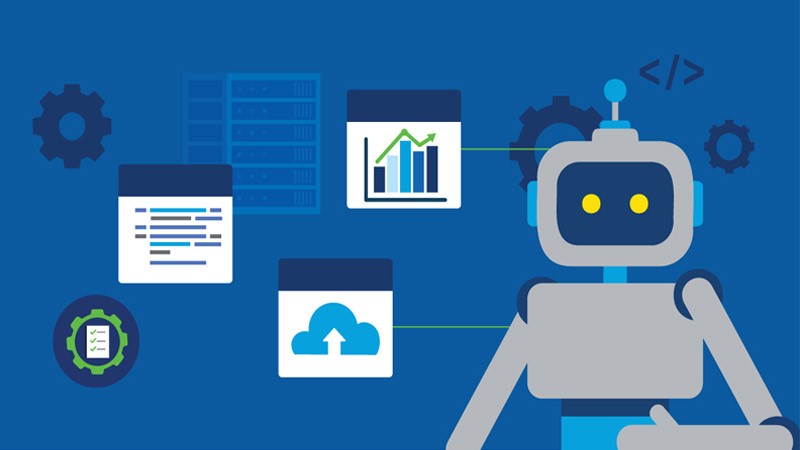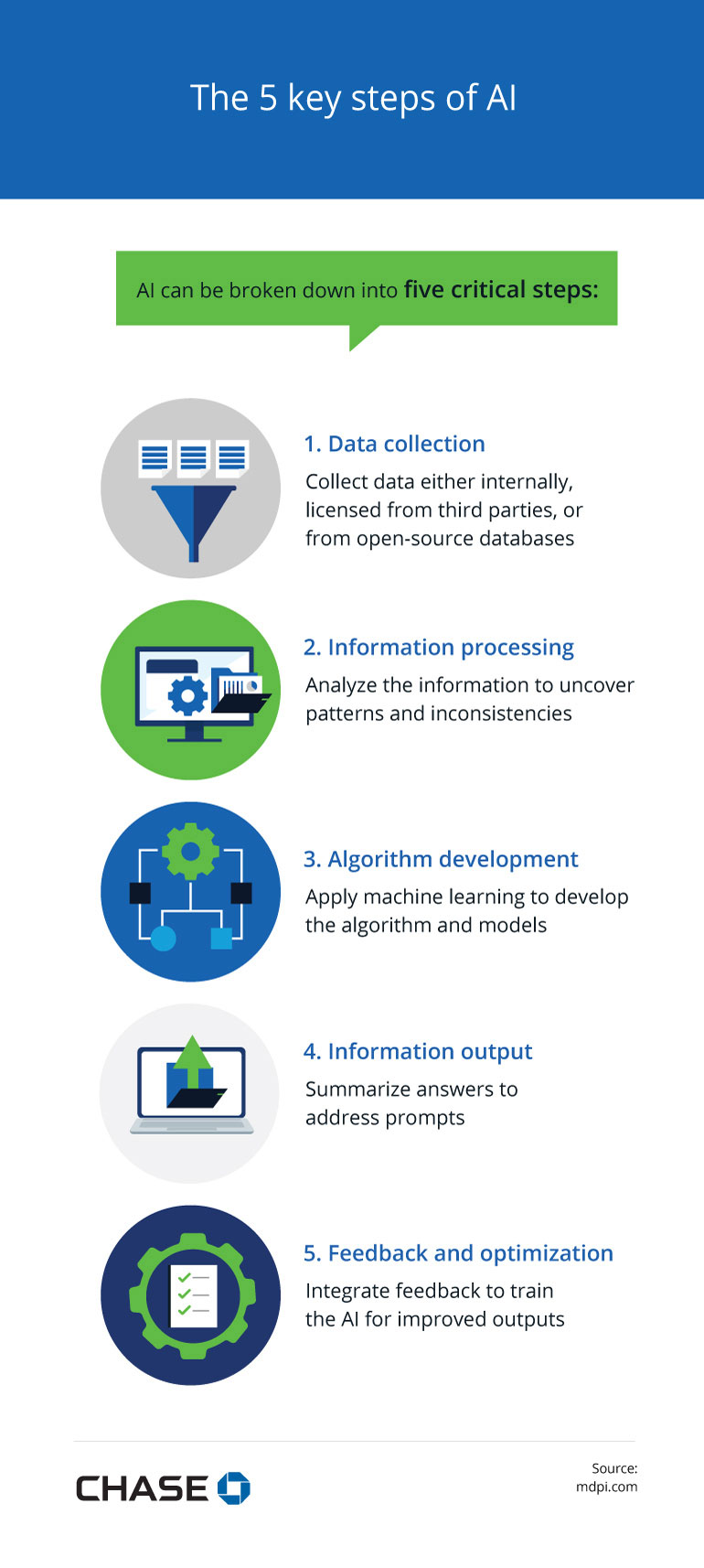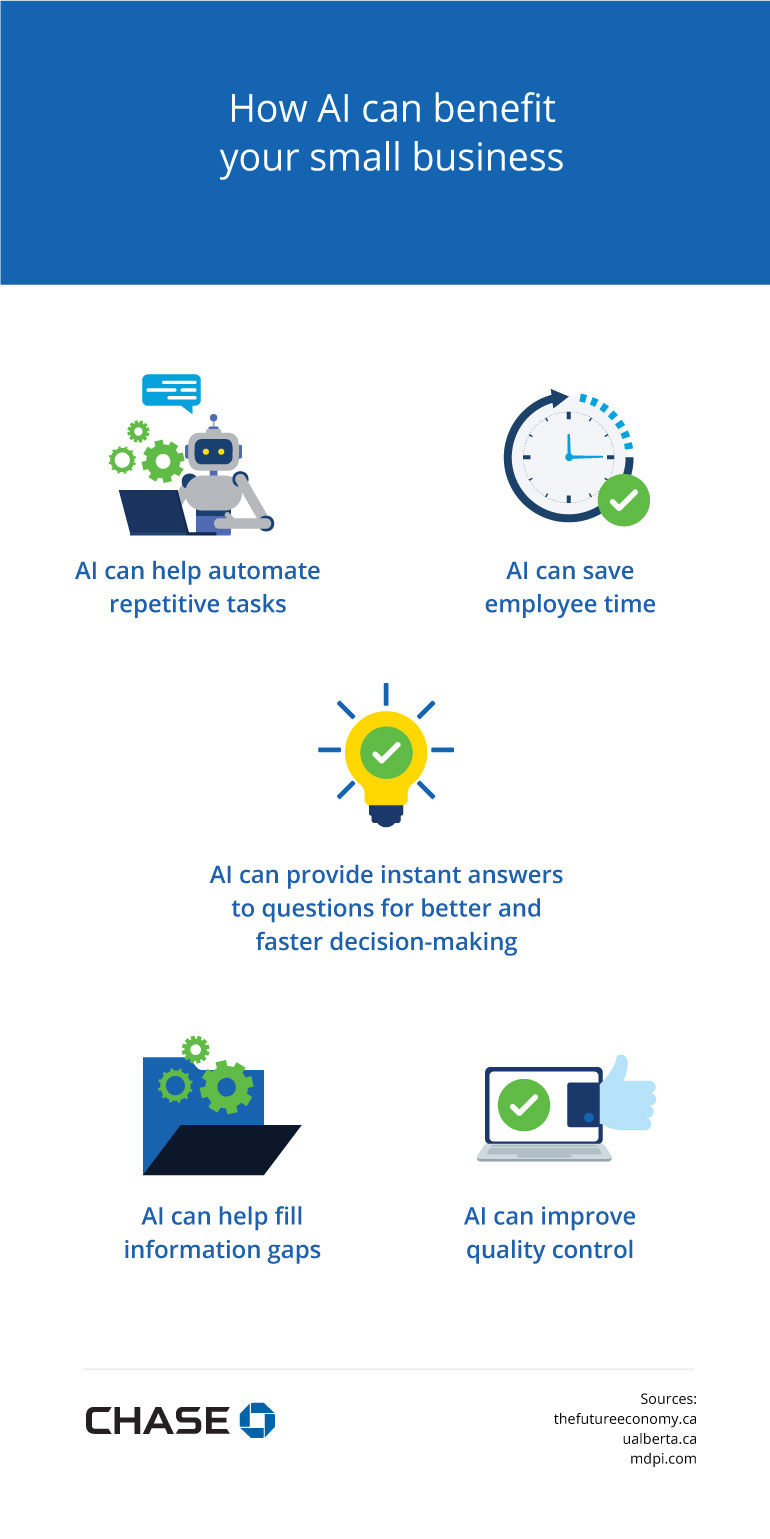How small businesses can benefit from AI
By Danny Wong

Canada is at the forefront of artificial intelligence (AI) innovation, investment, and application. The country ranks among the top five countries pioneering AI adoption in the Boston Consultancy Group’s AI Maturity Matrix. The government plans to invest $2 billion over the next five years to expand data centres, build infrastructure, and provide SMBs with affordable access to the computational power needed to train AI models.
Organizations turn to AI for accuracy, comprehensive answers, cost savings, and time savings. To stay competitive, small and medium businesses (SMBs) are turning to AI as well. This article explores the basics of AI, how to find opportunities to use it, different ways SMBs currently leverage it, and common concerns SMBs have about this emerging technology.

AI can be broken down into five critical steps:
- Data collection
Collect data either internally, licensed from third parties, or from open-source databases - Information processing
Analyze the information to uncover patterns and inconsistencies - Algorithm development
Apply machine learning to develop the algorithm and models - Information output
Summarize answers to address prompts - Feedback and optimization
Integrate feedback to train the AI for improved outputs
Source:
AI basics
AI is made up of five key components:
- Data collection
AI models, programs that apply algorithms (or automated instructions), gather data, which may be public, proprietary, or licensed. - Information processing
AI models analyze the data they’re given to find patterns, relationships, and anomalies. - Algorithm development
At this stage, AI applies machine learning — a subset of AI where computers learn to perform a task without being programmed to do so — to its algorithms. AI models develop smarter ways of processing and analyzing information, which helps them make their conclusions more quickly and accurately. The biggest limitation is the quality and quantity of the data provided to AI tools. - Information output
After each prompt (the questions or guidelines used to interact with an AI tool), AI provides answers or predictions. - Feedback and optimization
People can tailor their prompts to further refine the outputs. For instance, you can ask AI to use an empathetic tone or provide 10 options for a specific question. Providing more data or clarity can help the AI model generate responses that better suit individual needs in the future.
Just in the last few years, AI has shifted from experimental to having practical business applications. About 9.3% of Canadian businesses were using generative AI in 2024, according to a government survey, although the number may be higher than that. A BDC survey found that 27% of Canadian entrepreneurs were using AI without knowing it because it was embedded in tools they used.
AI can help SMBs analyze data, automate some operations, and streamline tasks. With the right tool and quality data, it’s already supporting smarter decisions and greater efficiency for some businesses. And, as AI evolves and computing power advances, it’s likely to become an even more valuable asset for SMBs.

- AI can help automate repetitive tasks
- AI can save employee time
- AI can provide instant answers to questions for better and faster decision-making
- AI can help fill information gaps
- AI can improve quality control
Sources:
- Upskilling in the Age of AI and Automation (2023, November 3). TheFutureEconomy.ca
- Machine learning uncovers missing information about ethnicity and Aboriginal status in population health data: study (2020, November 18). University of Alberta.
- Artificial Intelligence-Based Smart Quality Inspection for Manufacturing (2023, February 23).MDPI.
How to find opportunities to use AI
Effective use of AI requires a problem, useful data inputs, a specific prompt, actionable insight, and a feedback loop. Many SMBs wonder about the types of problems AI can solve and how they apply AI tools for their organizations. Below are five questions you can explore to determine different ways to implement AI tools at your company.
1. Where are tasks repetitive?
AI can streamline your processes and workflows by completing structured, repetitive tasks for your business.
Common examples include data entry, generating and analyzing reports, bookkeeping, and even email replies. A variety of AI applications for small business can receive specific instructions and integrate with your analytics dashboards, accounting software, and email accounts to complete repetitive tasks at scheduled intervals or whenever the AI models receive new information.
2. Where can you free up employee time?
In addition to handling repetitive tasks, AI can also take care of some time-consuming activities. From self-service chatbots to dynamic appointment scheduling, AI solutions can minimize human intervention and save your team hours of effort each week.
3. Where do you need answers quickly?
Sifting through data can feel like finding a needle in a haystack. While advanced spreadsheet formulas could help, they require technical knowledge and troubleshooting. Instead, you can use AI to pull answers out of vast amounts of data.
Finding specific information from a database or report can be completed easily and instantly with the right AI solutions. AI can save time and reduce the risk of human error — like, for example, in the case of inventory management. With AI, businesses can manage inventory in real time, predicting demand and reducing the likelihood of stockouts and overstocks.
4. Which circumstances require comprehensive answers?
Companies love to leverage AI to streamline workflows, save employees time, and analyze loads of data. AI for small business also works well when you need to fill in information gaps.
For instance, your employees may struggle to list all the components that go into a particular project or process. Trained AI models can instantly produce a comprehensive checklist. Team members may forget specific instructions or requirements for activities like posting on social media, editing existing posts, or uploading content to a common content management system. Even publicly available AI tools can generate a clear, step-by-step guide.
5. What are typical quality control scenarios?
Are your quality control processes manual or labour-intensive? You can integrate AI and improve quality assurance in a number of ways. For instance, you can build AI into your production line, fulfilment processes, inventory management systems, and real-time monitoring tools to offer alerts and notifications when issues arise.
How small businesses are using AI
Across Canada, SMBs in a wide variety of industries use AI in easy, creative, and sometimes sophisticated ways to improve their business intelligence, customer experience, cybersecurity, data handling, and supply chain operations.
A few common examples include:
- Analytics
AI can analyze customer behaviours, financial performance, marketing data, resource utilization, sales trends, and more. Then, it can highlight areas of success and provide actionable insight on areas that need improvement. - Content ideation
AI can be a great starting point when it comes to content creation. AI tools can offer content inspiration in the form of alternate headlines, topic ideas, suggested hashtags and emojis, and more to bolster marketing efforts. - Customer service and sales
Companies often use AI to power chatbots and email automation, offering customers and prospects helpful responses to guide them along the sales process. - Cybersecurity
AI can help with preventative and reactive solutions for cybersecurity. AI tools look for vulnerabilities in your data management and storage, communications tools, and website security. AI tools can also patch up any potential cybersecurity issues when they arise. - Data entry
AI scans the web, your private database, or a select data upload to summarize, categorize, and label the data in a manner that is useful for your business purposes. AI tools take a good chunk of the manual labour out of the process. You can ask AI to tackle a variety of information — from spreadsheets to text documents and even audio files. - Inventory management
Between demand forecasting, dynamic pricing, just-in-time ordering, shelf-life management, stock-level management, and warehouse optimization, AI can help with a wide variety of inventory-management tasks.
Implementing AI in a small business
Most SMBs don’t have the resources or funding to build their own AI models, so it usually makes more sense to invest in commercially available AI products. Here’s a strategic step-by-step approach for determining where your SMB can benefit most from AI, choosing the right tool, and setting it up for success.
1. Identify your operational inefficiencies
To determine where AI can be the most helpful in your SMB, take a look at where you’re struggling. Are manual processes, like invoicing or data entry, slowing your team down? Do you lack real-time data to help with decision-making? Are you struggling to respond promptly to customer inquiries and complaints?
2. Prioritize areas with ROI potential
Pick one inefficiency that AI has the potential to solve, and focus there first. Get specific about the metrics you want to improve. For example, if customer service is your biggest pain point, you may want to reduce your average first response time to 12 hours or aim for a 10% increase in your first contact resolution rate (the number of customer issues resolved in the first interaction).
3. Research AI tools
Once you know what problem you want to solve, compare AI tools that can help you solve it. For example, for customer service, you may want to look into tools that offer features like automated ticket routing, an automated answering service, or an AI-powered chatbot to answer frequently asked questions.
4. Select a vendor
- The tool integrates with your current systems, such as your customer relationship manager (CRM) software.
- The vendor offers a customized setup process and ongoing support.
- The tool complies with PIPEDA and other relevant Canadian privacy laws.
- The company offers examples of results other SMBs have achieved.
- You understand the total pricing, including any additional fees.
5. Pilot the tool
If possible, go with a company that offers a free trial period, so you can test the tool before you commit. Bring your team into the process, provide them with training, and gather their ongoing feedback. They’re likely to be more invested in a tool they helped test and select.
6. Monitor performance and metrics
Keep your eye on the specific goals you outlined in the second step of this process, and track your progress. Most AI tools offer dashboards and detailed reporting features to help you monitor metrics.
7. Scale
Once you’ve made progress on your first inefficiency, move on to your organization’s next biggest pain point. Then repeat the steps above.

- It’s expensive
- Enterprises spend a lot of money licensing AI tools, which can be cost prohibitive for SMBs.
- At the same time, SMBs can try dozens of free AI solutions for a wide spectrum of needs.
- It’s complicated
- Some AI platforms need custom integrations or specialized programming.
- Other platforms offer no-code solutions, and companies can offer education programs to get employees up to speed.
- It’s a security risk
- Many AI tools plug into company databases and systems, which can cause a security vulnerability.
- Though security isn’t guaranteed, you can minimize your risk by allowing only limited access to company systems or using third-party data instead.
- It’s irrelevant
- Some businesses may think AI won’t work for their organization.
- Beyond the many AI use cases companies already employ, new ones continue to emerge.
Sources:
- Canada’s AI imperative - Overcoming risks, building trust (2019, April 19). Deloitte (PDF).
- Generative artificial intelligence (AI) - ITSAP.00.041 (2023, July 14). Government of Canada
- Generative AI and Canadian businesses: Why a holistic approach is key to harnessing the disruptive potential of this fast-changing technology. PwC Canada.
Small business concerns about AI
SMBs may feel hesitant to adopt AI due to the following concerns:
- It’s expensive
While the potential cost of certain AI solutions may feel like a barrier, many tools are free and offer a variety of use cases. Other AI tools are available with per-use pricing or a monthly or annual licence fee. The costs vary widely depending on business needs and the provider, but you can still benefit from free solutions as you begin to integrate AI into your operations. - It’s complicated
Advanced use cases may require custom integrations with company data or third parties. With that said, you can still use AI for different data sets and tasks that integrate quickly or require no technical integrations at all. - It’s a security risk
Certain AI tools need access to proprietary data and systems. This level of access can lead to new attack vectors and vulnerabilities. Though security isn’t guaranteed — even with a paid service — you can minimize your risk by giving AI platforms limited access to private data or by using public or third-party data services only. - It’s irrelevant
Some people dismiss the benefits of AI. A few quick demos might not be enough to convince business owners to use AI tools regularly. Take the time to investigate your options and learn how you could best onboard and use them.
While the concerns above are valid, you can find free or cost-effective AI solutions that are easy to use, integrate, and create safeguards for. No matter the industry or company size, small business owners can find AI use cases that create a net benefit for their customer experience, organization, and workflows.
Future Trends: What’s Next for Small Business AI?
While large businesses have led the way with AI adoption in Canada, SMBs may be poised to catch up. As the Canadian government and venture capitalists continue to invest in AI, these tools could become more accessible and affordable for SMBs. However, it’s also possible that pricing will fluctuate as the market matures. For example, if venture funding declines and providers shift their focus toward profitability, prices for some tools could rise, similar to what we’ve seen before with cloud storage services and video conferencing software.
AI tools will continue to be integrated into everyday technologies, from CRM to accounting software. And SMBs will likely increasingly experiment with generative AI tools to help them draft emails, write reports, and create basic content, although human oversight and input will remain essential for quality and accuracy. About 69% of Canadian businesses that adopted AI in a Business Data Lab study (PDF) wanted to use it to accelerate content creation, 46% aimed to automate work without reducing employment, and 38% sought to improve the customer experience.
The same study provides clues about which industries are likely to adopt AI most rapidly. Companies in the information and culture sector, professional services, and finance and industry may continue to lead in adoption, while businesses in agriculture, forestry, fishing, and construction may continue to lag.
Moving forward with AI
SMBs can leverage AI to enhance business processes, increase operational efficiency, and stay competitive. While concerns may arise before teams decide to employ AI tools for small businesses, you can overcome those objections and reiterate the potential of AI implementation. One way is to pilot AI solutions to open the door for more discovery and discussion around expanding AI usage within your organization.